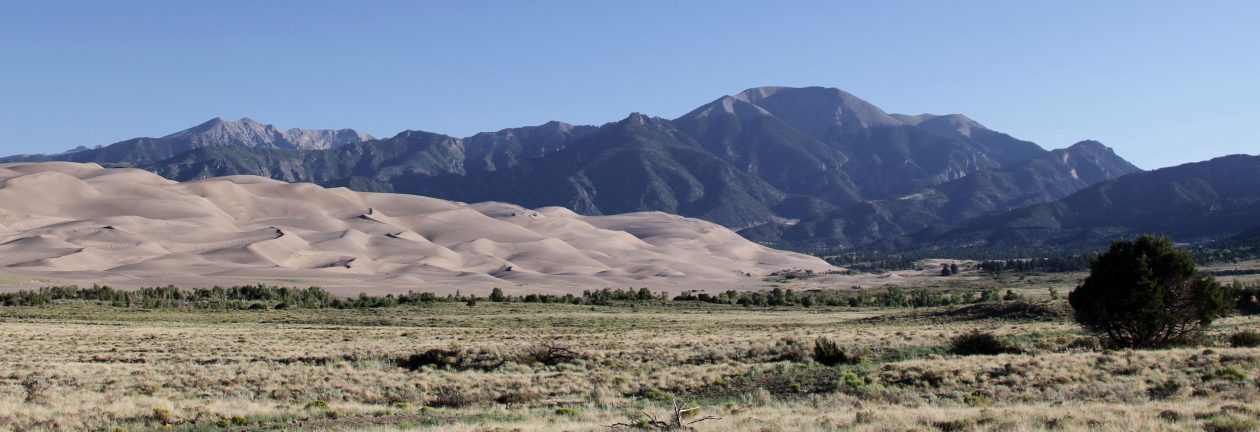Agra, India
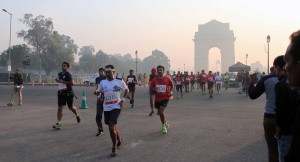
I woke up today at 05:00 and got ready for my tour to Agra which was scheduled to begin at 06:00; I soon found out that three other hotel guests (an Indian man and his grandparents) and I would not be picked up until 06:30; we were actually picked up closer to 06:50 and taken down to the street where my tour yesterday had begun. We then took a bus to be dropped off at another location where our actual bus was to meet us. Eventually, after being dropped off on the side of the road, our tour bus came and picked us up (funny how this works, yesterday I ordered a bus with air conditioning, but the driver never turned it on; learning from this, I ordered a regular bus without air-conditioning and I end up getting one with it and more leg room – this is obviously a haphazard operation). I sat down next to the Indian man and talked with him while our bus drove around New Delhi picking up other passengers. We then came upon a police barricade blocking traffic from interrupting a half marathon that was taking place near the India Gate (of course our tour operators knew nothing about this international event; after all, marathons strike like tornadoes); since we were now stuck in traffic, I exited the bus to get a glimpse of the half marathon and find out how long we might be waiting (it looked like it had just started); when I walked back to the bus, I saw that it was now backing up, just as the cars behind us had done, and we could now drive around the marathon. We continued on our way, picking up the rest of the passengers, and exiting New Delhi at 09:00 (two hours past what I had expected, two hours of wasted sunlight – next time, I will take the train to Agra). During the drive to Agra, we stopped at a rest stop along the very wide and modern highway and continued onward; the whole journey took nearly four hours before we reached Agra; once in Agra, we also picked up a tour guide who could at least explain some things in English to me (Note: the tours I took yesterday and today are actually domestic Indian tours and both times I was the only Westerner on the bus).
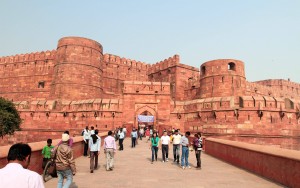
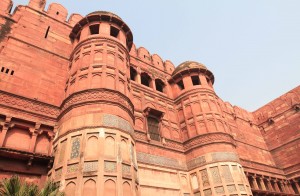
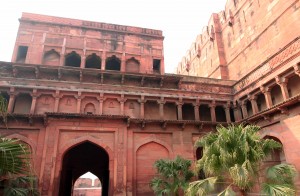
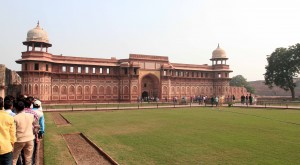
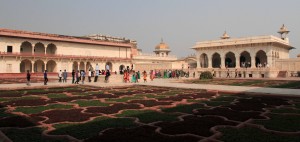
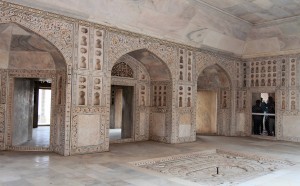
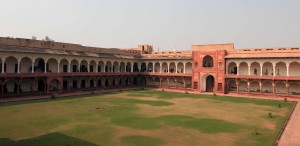
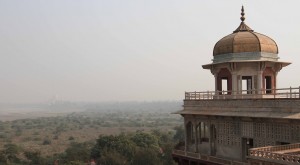

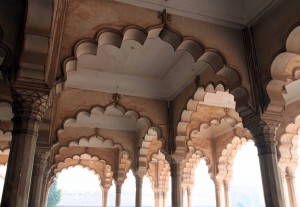
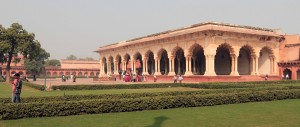
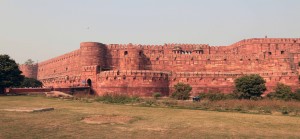
Our first stop was the Agra Fort; the original brick fort that stood here was built some time before 1080 AD and was known as “Badalgarh”; in 1526 AD, the Mughals captured the fort, seizing a vast treasure; in 1558 AD, Akbar I made Agra his capital and rebuilt the fort in red sandstone (construction lasted eight years and was completed in 1573 AD); during the reign of Akbar’s grandson, Shah Jahan, the fort took on its present state. Our tour guide led us around the premises, telling us that only about 25% of the fort is open to the public and the army is in charge of the other 75%. We walked through the Amar Singh Gate, then to the Jahangiri Mahal, past the Shish Mahal (“Glass Palace”) and Khas Mahal, and through the Diwan-i-Am (“Hall of Public Audience”); we also could see the Taj Mahal, next to the bank of the Yamuna River, from the rooftops of Agra Fort, but it was very hazy in the distance. We then finished up our tour and made our way back to the bus. After that incredible site, we drove to a “government sanctioned” shop that specializes in marble products and leather (tour buses come here to help ensure tourists buy the real thing and not what touts are peddling on the street; the shop owners even demonstrated the translucent property of real marble to let tourists know how to check souvenirs in the future). Once passengers were finished buying their gifts, we were driven to a restaurant for lunch; I didn’t like anything on the menu, so I went hungry the rest of the day.

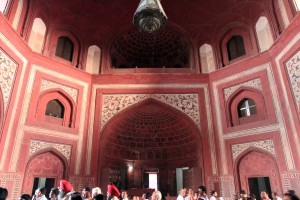
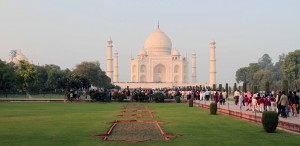
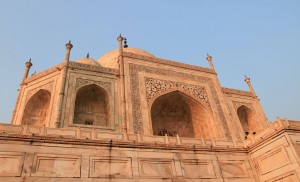
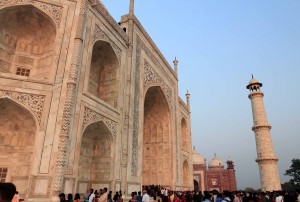
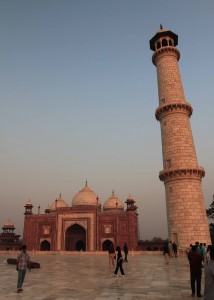
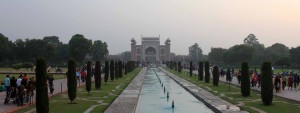
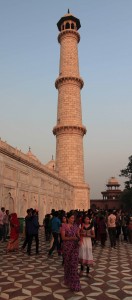
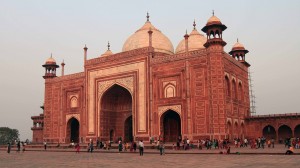
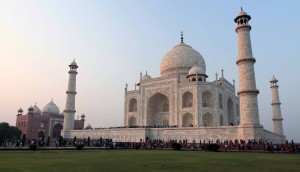
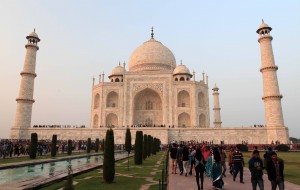
After our late afternoon lunch, we drove to the Taj Mahal entrance where we exited the bus and had to take government operated transport buses to the historic site, which was about one kilometer away. Upon arriving at the real entrance, we exited the government buses and lined up for the invasive security check (I’ve noticed security guards at these check points love to pick on foreign tourists, as if the white dude with the camera is the likely terrorist – it’s not like this is Ireland or a former USSR state; we all know that if anyone causes trouble in India, that they’re most likely from that terrorist friendly nation up north); I then learned that camera tripods are not allowed in the Taj Mahal site and one of the official government photographers who latched on to our tour stowed it away at a nearby shop for me; after that nonsense, I entered through the Darwaza-i Rauza (the “Great Gate of the Mausoleum”) and gazed upon the magnificent structure that is the Taj Mahal; that gigantic white marble mausoleum got more and more impressive the closer I got to it. The Taj Mahal was built by the Mughal Emperor, Shah Jahan, in memory of his third wife, Mumtaz Mahal (she must have been the best of his wives); construction began in 1632 AD and was completed in 1648 AD. I walked up to the mausoleum, used the machine nearby to wrap my shoes up (makes it easier than taking your shoes off and having them stolen), and then queued in line to enter inside and see the tomb of Mumtaz Mahal; once I was let inside (after tons of people pushed each other out – there is only one entrance and the Indian government hasn’t figured out that a divider would do wonders here (one side in, the other out, keep the line moving, etc.)), I quickly walked around the tomb and reached the entrance again, but then I had to wait until the inside was crammed full of sweaty, inconsiderate people before we were let out. After that experience, I walked around the top part of the Taj Mahal, before heading back down to the gardens south of the structure. I took many pictures, but since I didn’t have my tripod, I had to rely on others to take pictures of me – sadly, few people on this planet can properly frame a picture, so I had to take what I could get. I then met up with the Indian man and his grandparents and we walked back out of the gate and took the government bus back to our bus; we were late making it back, but were some of the first passengers to return; many were stuck in the long lines to enter inside the Taj Mahal; so I had to wait in a trashy parking lot for over a half hour before everyone returned (wish I spent that time within sight of the Taj Mahal instead, oh well). The bus then departed Agra and drove on to our next stop.
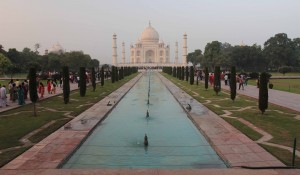
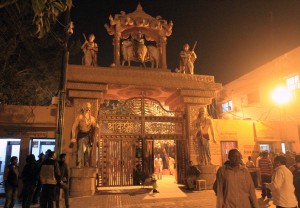
Ninety minutes later (shortly after 20:00), we reached Mathura, the city where Krishna was born. The bus parked about ten minutes away from the entrance; I exited and followed everyone else through the nighttime streets to the entrance to Shri Krishna Janmbhoomi, the temple built on the site of the prison cell that Krishna was believed to have been born in. At the entrance, I met up with the Indian man and his grandparents; we both had mobile phones and cameras to store, but the cloak room line at this entrance was too chaotic; so we walked to an alternate entrance, quickly stored our stuff, entered in to the temple complex, took our shoes off, hurried through the shrine on the spot where Krishna was born (moving much too quickly in the short amount of time given at this stop), and then hurried out, putting our shoes back on, and grabbing our goods from the cloak room. We then walked back to the bus. Once all the passengers were back on board, the bus drove on to Vrindavan, a nearby town where Krishna grew up and played in; at this point I was too tired and it was too dark outside; so I decided to stay and sleep on the bus as everyone spent almost an hour to see a temple built on one of the spots Krishna played as a child. This was our last stop and once all the passengers were back on, the bus drove back to New Delhi. I fell asleep for about three hours before the bus reached New Delhi and began dropping passengers off throughout the city. By the time the Indian man and his grandparents and I returned to ouyr hotel, it was 02:46. I was exhausted and soon fell asleep.
